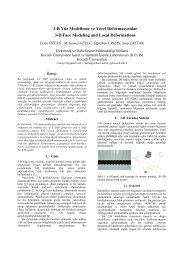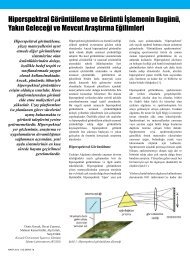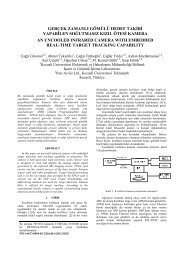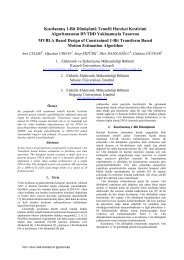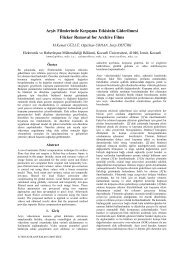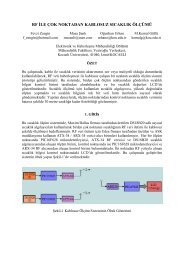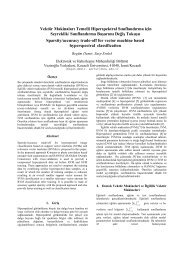Motion estimation by pre-coded image planes matching ... - KULIS
Motion estimation by pre-coded image planes matching ... - KULIS
Motion estimation by pre-coded image planes matching ... - KULIS
You also want an ePaper? Increase the reach of your titles
YUMPU automatically turns print PDFs into web optimized ePapers that Google loves.
PClPM also achieves better performance than GC-BPM<br />
on a frame-to-frame basis. The PSNR of reconstructed<br />
sequences is always superior to GC-BPM, and a good<br />
deal closer to MAD. Table 11 shows for various sequences<br />
the maximum difference in the PSNR of frames<br />
reconstructed with MAD on one hand and GC-BPM and<br />
PClPM on the other. It is seen that on a frame-<strong>by</strong>-frame<br />
hasis PClPM achieves up to 1dB better than GC-BPM.<br />
Video Sequences<br />
Method<br />
FootballlSalesmanlTennis(Flowergardenl Mobile<br />
“- I 0.74 I I 1.39 1.50 I 0.65 1.39<br />
BPM<br />
Table 11. Maximum difference in the PSNR of frames<br />
reconstructed with MAD on one hand and GC BPM and<br />
PCIPM on the other.<br />
4. CONCLUSIONS<br />
A novel motion <strong>estimation</strong> procedure based on <strong>pre</strong>-<strong>coded</strong><br />
<strong>image</strong> plane <strong>matching</strong> has been <strong>pre</strong>sented. Reduction in<br />
the ME <strong>matching</strong> evaluation is achieved <strong>by</strong> adding<br />
redundancy to the pixel re<strong>pre</strong>sentation, approximating the<br />
mean absolute difference criterion. While the increase in<br />
the number of bit <strong>planes</strong> requires the utilization of a<br />
larger number of EX-OR calculations, as EX-OR<br />
<strong>matching</strong> of <strong>coded</strong> bit-<strong>planes</strong> is accomplished<br />
simultaneously the EX-OR <strong>matching</strong> process is<br />
accomplished in a single gate delay, suitable for a fast and<br />
simple hardware implementation.<br />
5. REFERENCES<br />
[I] Z.-L. He, C.-Y. Tsui. K.-K. Chan, and M.L.Liou,<br />
“Low-power VLSI design for motion <strong>estimation</strong> using<br />
adaptive pixel truncation,” IEEE Trans. Circuits Syst.<br />
Video Technol., vol.10, pp. 669-678, Aug. 2000.<br />
[2] M. Mattavelli, and G. Zoia: “Vector-tracing algorithm<br />
for motion <strong>estimation</strong> in large search windows,” IEEE<br />
Trans. Circuits Syst. Video Technol., vol.lO, pp, 1426-<br />
1437, Dec. 2000.<br />
[3] J. Feng, K.-T. Lo, H. Mehrpour, A. E. Karbowiak,<br />
“Adaptive block <strong>matching</strong> motion <strong>estimation</strong> algorithm<br />
using bit-plane <strong>matching</strong>,” in Proc. lClP’95, pp. 496 499,<br />
1995.<br />
[4] X. Lee and Y. Zhang, “A Fast Hierarchical <strong>Motion</strong>-<br />
Compensation Scheme for Video Coding Using Block<br />
Feature Matching,” IEEE Trans. Circuit Syst. Video<br />
Technol., vol. 6, pp. 627 - 635, Dec. 1996.<br />
[5] P. H. W. Wong and 0. C. Au, “Modified One-Bit<br />
Transform for <strong>Motion</strong> Estimation,” IEEE Trans. Circuit<br />
Syst. Video Technol., vol. 9, pp. 1020 - 1024, Oct. 1999.<br />
[6] S.-J. KO, S.-H. Lee, S.-W. Jeon, and E.-S. Kong, “Fast<br />
digital <strong>image</strong> stabilizer based on Gray-<strong>coded</strong> bit-plane<br />
<strong>matching</strong>“, IEEE Trans. Consumer Electronics., vol. 45,<br />
pp. 598-603, Aug. 1999.


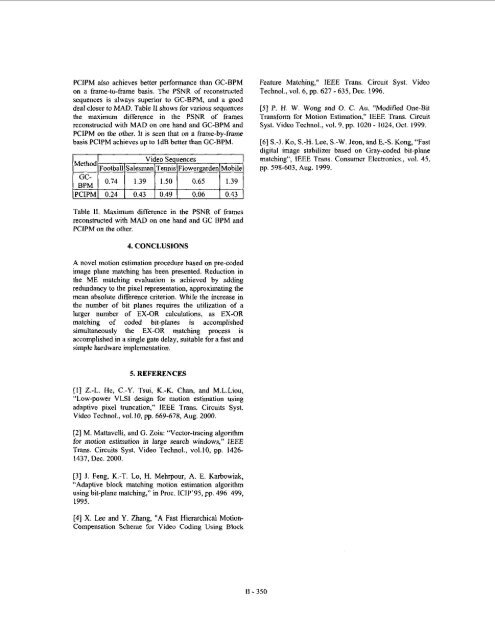


![Page 1 %XODQÕN 6 ]JHo LOH *|U QW 6WDELOL]DV\RQX M ...](https://img.yumpu.com/18085529/1/184x260/page-1-xodqon-6-jho-loh-u-qw-6wdeloldvrqx-m-.jpg?quality=85)
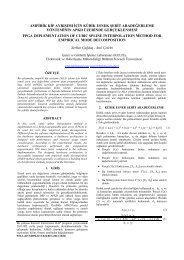
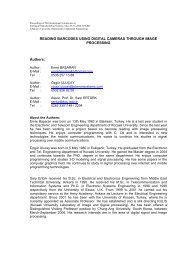
![[ ]T [ ]T - KULIS - Kocaeli Üniversitesi](https://img.yumpu.com/18085463/1/184x260/-t-t-kulis-kocaeli-universitesi.jpg?quality=85)
